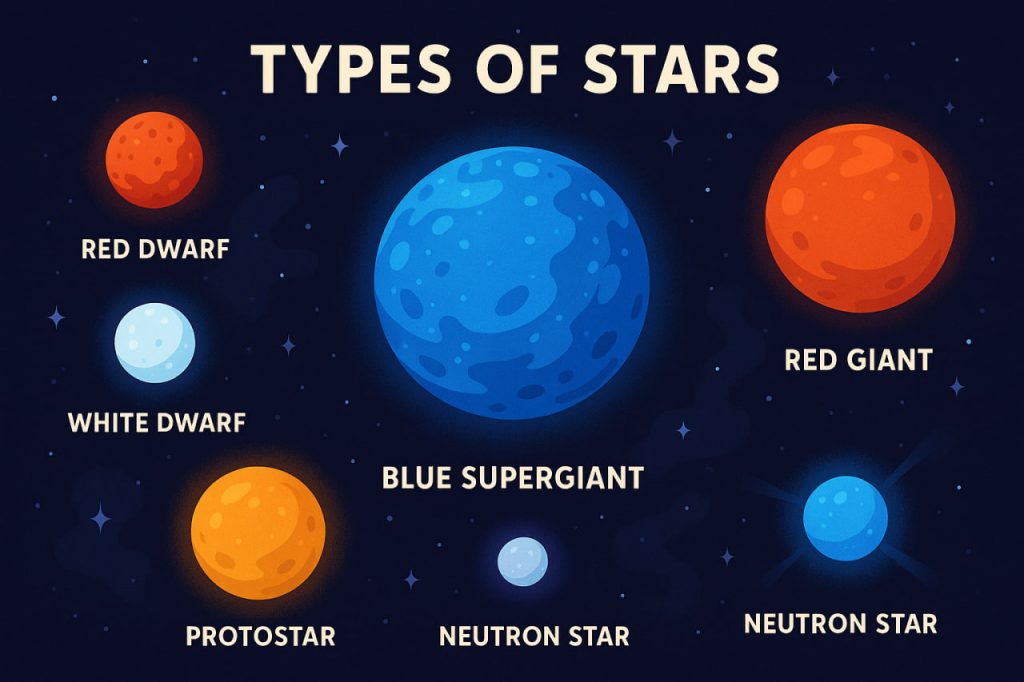Stars are massive, glowing spheres of hot gas — primarily hydrogen and helium — that produce energy through nuclear fusion. They vary greatly in size, color, temperature, brightness, and lifespan. These differences allow astronomers to classify stars into distinct types, from tiny red dwarfs to colossal blue supergiants.
Understanding the types of stars helps us grasp how galaxies evolve and how elements that form planets and life are created.
Main Types of Stars by Mass and Temperature
Stars are classified using the Harvard spectral classification system, which orders stars by temperature using the letters:
O – B – A – F – G – K – M
(From hottest to coolest)
You can remember it with: “Oh Be A Fine Girl/Guy, Kiss Me.”
O-Type Stars (Blue Supergiants)
- Extremely hot and bright
- Surface temperature: > 30,000 K
- Very rare and short-lived
- Example: Zeta Puppis
B-Type Stars
- Very luminous and blue-white
- Surface temperature: 10,000–30,000 K
- Found in young star clusters
A-Type Stars
- White or bluish-white
- Surface temperature: 7,500–10,000 K
- Example: Sirius A
F-Type Stars
- Yellow-white stars
- Surface temperature: 6,000–7,500 K
- Often host planetary systems
G-Type Stars
- Yellow stars like our Sun
- Surface temperature: ~5,500–6,000 K
- Moderate in mass and lifespan
- Example: Sun (G2V)
K-Type Stars
- Orange in color
- Cooler and smaller than the Sun
- Surface temperature: 3,500–5,000 K
- Long-lived, often stable
M-Type Stars (Red Dwarfs)
- The most common stars in the universe
- Coolest and dimmest
- Surface temperature: < 3,500 K
- Very long lifespans (trillions of years)
Special and Evolved Types of Stars
As stars age, they evolve into other forms depending on their initial mass:
Red Giants
- Formerly small or medium stars (like the Sun)
- Outer layers expand and cool as the core shrinks
- Example: Betelgeuse
White Dwarfs
- Final stage of small stars
- Very dense, Earth-sized remains of stars like the Sun
- No longer undergo fusion
Neutron Stars
- Collapsed cores of massive stars after supernova
- Extremely dense — a teaspoon weighs billions of tons
- Some rotate rapidly and emit radio waves (called pulsars)
Black Holes
- End result of the most massive stars
- Gravity so strong that not even light escapes
Protostars
- Newborn stars forming inside clouds of gas and dust
- Not yet undergoing fusion
Binary and Variable Stars
- Binary stars: Two stars orbiting each other.
- Variable stars: Change brightness over time (like Cepheid variables, used to measure distance in space).
Glossary
- Nuclear fusion — the process where atomic nuclei combine to release energy, powering stars.
- Spectral type — a classification system based on a star’s temperature and color.
- Red dwarf — a small, cool, long-living star.
- Supernova — a powerful explosion that ends the life of a massive star.
- Neutron star — the extremely dense remnant of a supernova.


